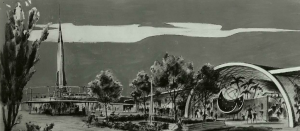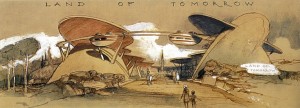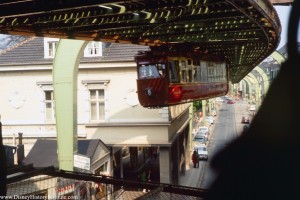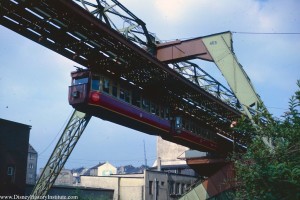Monorail Tales – Part 1
The Disneyland Monorail That Almost Was
The Disneyland Monorail That Almost Was
by Todd James Pierce
Back in 1954, as Walt was gearing up for Disneyland, he assigned Herb Ryman the task of creating concept art for the “Land of Tomorrow”–or Tomorowland, as it would later be called. Front and center, across the entrance way to Tomorrowland, was a monorail. But it was not the German-saddle-type Monorail that would eventually find a home at Disneyland. That style of monorail–with its precise spring rates and side-straddle wheels–hadn’t yet been fully developed. The original monorail was the “hanging-basket” monorail in which the passenger cars hung below the track. Specifically, the original Disneyland monorail was modeled largely on the Wuppertal-style monorail in Germany. That is, the Wuppertal track-and-bogie system with futuristic cars.
This hanging monorail would not only zip across the entrance, it would have a circular station and load platform in the center of Tomorrowland–right where the PeopleMover would find its elevated load area in 1967.
 |
| Tomorrowland, with Monorail Station – 1954 |
But before I venture further and explain why this monorail never showed up at Disneyland, I need to point out something that may be obvious. In recent posts, I’ve talked about how Disneyland, back in the 1950s, was envisioned as a cinematic park in which Hollywood set design was applied to real world settings. But there were other design concepts that were applied throughout the park, including this one: Disneyland would showcase past, current and future forms of transportation. If you think back to those original 1955 attractions, you’ll find that roughly half were actual transportation systems, which allowed Disneyland to function in part as a working transportation museum. These attractions included the Santa Fe and Disneyland Railroad, the Mark Twain riverboat, the Conestoga wagons, the stagecoaches, the pack mules, the Tomorrowland Boats, Autopia, and of course all of the Main Street vehicles. There’s even a case to be made that, essentially, Rocket to the Moon (a simulator attraction) functioned within this category. Within this design scheme, a monorail would’ve been a natural fit for Disneyland. So why wasn’t this hanging monorail built?
| Wuppertal Monorail 1955 |
In the mid-1950s, during one of Walt’s trips to Germany, he ventured onto the Wuppertal monorail with his wife, Lillian. It was mainly Lillian, at first, who objected to the ride system. The hanging cars tended to swing out around curves, so much so that she became queasy. The train was rickety and loud, with the wheels passing over the metal track. And for Walt, there was one other issue: the view of the river and city was constantly interrupted by unattractive steel support beams. It made one feel caged in behind a system of bars. And so with this, Lillian’s disapproval coupled with the unattractive track system, the monorail project was put on hold until a more attractive and futuristic alternative could be found.
For today’s post, I’ve assembled a slideshow of the Wuppertal monorail (or the Wuppertalbahn for you locals). For a while now, I’ve collected images of places that Walt visited as he developed his amusement parks. The slideshow is comprised of images of the Wuppertal monorail in 1955 and 1962; that is, these images correspond closely to what Walt and Lillian would’ve experienced as they rode the Wuppertalbahn through the city and alongside the river. As usual, these images are new and never-before-published. So, for a moment, imagine what Walt saw as he contemplated adding a monorail like this to his park.
Click Here for Monorail Tails – Part 2




The preliminary sketch on your post…now THAT’S an entrance!
Great post, super details and photos Is the “Wuppertal” still running today?
Yes it is, and it’s still as uncomfortable to ride on as it was back then. Incidentally, we call it the “Schwebebahn”, not the Wuppertalbahn.